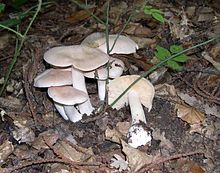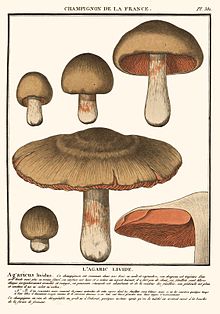Entoloma sinuatum
| Entoloma sinuatum | |
|---|---|

| |
| E. sinuatum, Piacenza's Appennino, Italy | |
| Scientific classification | |
| Domain: | Eukaryota |
| Kingdom: | Fungi |
| Division: | Basidiomycota |
| Class: | Agaricomycetes |
| Order: | Agaricales |
| Family: | Entolomataceae |
| Genus: | Entoloma |
| Species: | E. sinuatum
|
| Binomial name | |
| Entoloma sinuatum (
Pers.) P.Kumm. (1871) | |
| Synonyms[1] | |
| Entoloma sinuatum mycorrhizal | |
|---|---|
| Edibility is poisonous | |
Entoloma sinuatum (
When young, it may be mistaken for the
Name and relationships

The saga of this species' name begins in 1788 with the publication of part 8 of
For many years Quélet's name and description were treated as valid because Bulliard's name antedated Persoon's. However, in 1950, a change in the
In the meantime, it had been widely accepted that the 1950 change to the Stockholm Code caused more problems than they solved, and in 1981, the Sydney Code reinstated the validity of pre-1801 names, but created the status of
| |||||||||||||||||||||||||||||||||
phylogenetic relationships of E. sinuatum and closely related fungi in the Rhodopolioid clade.[22]
|
The
Within the large genus Entoloma, which contains around 1500 species, E. sinuatum has been classically placed in the
Description

The largest member of its genus,
The stout white stipe lacks a
Similar species
Confusion with the highly regarded miller or sweetbread mushroom (Clitopilus prunulus) is a common cause of poisoning in France; the latter fungus has a greyish -white downy cap and whitish decurrent gills which turn pink with maturity.[28] Young fruit bodies of Entoloma sinuatum can also be confused with St George's mushroom (Calocybe gambosa),[23] although the gills of the latter are crowded and cream in color, and the clouded agaric (Clitocybe nebularis), which has whitish decurrent gills and an unusual, starchy, rancid or rancid starch odor.[30] To complicate matters, it often grows near these edible species.[34] Its overall size and shape resemble members of the genus Tricholoma, although the spore color (white in Tricholoma, pinkish in Entoloma) and shape (angular in Entoloma) help distinguish it.[35] The rare and edible all-white dovelike tricholoma (T. columbetta) has a satiny cap and stem and a faint, not mealy, odor.[28] E. sinuatum may be confused with Clitocybe multiceps in the Pacific Northwest of North America, although the latter has white spores and generally grows in clumps.[35] A casual observer may mistake it for an edible field mushroom (Agaricus campestris),[27] but this species has a ring on the stipe, pink gills that become chocolate-brown in maturity, and a dark brown spore print.[36] The poorly known North American species E. albidum resembles E. sinuatum but is likewise poisonous.[35]
Distribution and habitat
Entoloma sinuatum is fairly common and widespread across North America[35] as far south as Arizona.[37] It also occurs throughout Europe and including Ireland and Britain,[38] though it is more common in southern and central parts of Europe than the northwest.[33] In Asia, it has been recorded in the Black Sea region,[39] the Adıyaman Province in Turkey,[40] Iran,[41] and northern Yunnan in China.[42]
The fruit bodies of E. sinuatum grow solitarily or in groups,
Toxicity
This fungus has been cited as being responsible for 10% of all
A study of trace elements in mushrooms in the eastern Black Sea Region of Turkey found E. sinuatum to have the highest levels of copper (64.8 ± 5.9 μg/g dried material—insufficient to be toxic) and zinc (198 μg/g) recorded.[53] Caps and stalks tested in an area with high levels of mercury in southeastern Poland showed it to bioaccumulate much higher levels of mercury than other fungi. The element was also found in high levels in the humus-rich substrate.[54] Entoloma sinuatum also accumulates arsenic-containing compounds. Of the roughly 40 μg of arsenic present per gram of fresh mushroom tissue, about 8% was arsenite and the other 92% was arsenate.[55]
See also
- List of deadly fungi
- List of Entoloma species
Footnotes
- ^ Which means that under the modern principles of nomenclature, Persoon, not Bulliard, is the first to have used the name, since only names in Latin can be considered.
- ^ It is now generally accepted the species in question is Pluteus cervinus.
- ^ a b Initially presumed to be Entoloma prunuloides but later found to be distinct from that taxon.[22]
References
- ^ "Entoloma sinuatum (Bull.) P. Kumm". Species Fungorum. CAB International. Retrieved 2010-12-18.
- ^ "Entoloma sinuatum · livid pinkgill". The British Mycological Society. Archived from the original on 2022-02-05. Retrieved 2021-05-21.
- ^ "Entoloma sinuatum · livid pinkgill". NBN Atlas. Retrieved 2021-05-21.
- ^ "Entoloma sinuatum (Pers.) P. Kumm. - Livid Pinkgill". First Nature. Retrieved 2021-05-21.
- ISBN 9780816614073.
- ^ JSTOR 1224635.
- ^ Bulliard, Pierre (1782). Herbier de la France (in French). Vol. 8. Paris: Chez l'auteur, Didot, Debure, Belin. p. plate 382.
- ^ (in Latin)Quélet, Lucien (1872). "Les Champignons du Jura et des Vosges". Mémoires de la Société d'Émulation de Montbéliard. 2 (in French). 5: 116.
- ^ a b c d e Redeuilh, Guy (1995). "Etude préliminaire en vue de la conservation d'Entoloma lividum Quél". Bulletin de la Société Mycologique de France (in French). 111 (3): 155–68.
- ^ Persoon, Christian H. (1801). Synopsis Methodica Fungorum (in Latin). Gottingen, Sweden: Apud H. Dieterich. p. 329.
- ^ Kummer, Paul (1871). Der Führer in die Pilzkunde (in German) (1st ed.). Zerbst, Germany: Luppe. p. 98.
- ^ JSTOR 3792891.
- ^ Quélet L. (1886). Enchiridion Fungorum in Europa media et praesertim in Gallia Vigentium. p. 57.
- ^ ISBN 3-7682-0143-0.
- ^ a b Noordeloos, Fungi Europaei, p. 13.
- ^ ISBN 3-87429-254-1.
- ^ Fries, Elias Magnus (1821). Systema Mycologicum, volume 1. Lund: Officina Berlingiana. p. 197.
- ^ Romagnesi, Henri (1978). "Quelques Espèces Méconnues ou Nouvelles de Macromycètes. IV". Bulletin de la Société Mycologique de France (in French). 94 (2): 97–108.
- ^ Noordeloos, Machiel E. (1985). "Notulae ad floram Agaricinam Neerlandicam X-XI. Entoloma". Persoonia. 12 (4): 457–62.
- ISBN 3-85604-240-7.
- JSTOR 1224527.
- ^ PMID 20198166. Archived from the original(PDF) on 2011-07-24.
- ^ ISBN 0-14-063006-6.
- ISBN 0-304-52257-0.
- ISBN 0-395-93608-X.
- ISBN 0-395-91090-0.
- ^ ISBN 1-870630-09-2.
- ^ ISBN 3-8331-1239-5.
- ^ Noordeloos, Fungi Europaei, p. 72.
- ^ ISBN 0-222-79409-7.
- ISBN 0-7234-1576-5.
- ^ Noordeloos, Fungi Europaei, p. 114.
- ^ a b c d Noordeloos, Fungi Europaei, pp. 111–13.
- ^ ISBN 0-584-10324-7.
- ^ ISBN 0-8166-1407-5.
- ISBN 0-7627-3109-5.
- ^ Bates, Scott T. (2006). "A preliminary checklist of Arizona macrofungi" (PDF). Canotia. 2 (2): 47–78. Archived from the original (PDF) on 2011-04-19. Retrieved 2011-01-03.
- ^ "Northern Ireland's Herbarium Specimens". Northern Ireland Fungus Group. 2007. Archived from the original on 2019-02-07. Retrieved 2008-02-01.
- ^ Sesli, Ertuğrul (2007). "Preliminary checklist of macromycetes of the East and Middle Black Sea Regions of Turkey" (PDF). Mycotaxon. 99: 71–74.
- doi:10.5248/110.43.
- ISBN 978-964-2725-29-8.
- ISSN 0029-0289.
- ^ Noordeloos, Fungi Europaei, p. 38.
- ISBN 3-921703-77-8.
- S2CID 259999146.
- ^ Chapuis, J.-R. (1984). "Jahresbericht des Verbandstoxikologen für das Jahr 1983 [Annual Report of the SUSM Toxicologist for 1983]". Schweizerische Zeitschrift für Pilzkunde (in German). 62: 196–97.
- ISSN 0393-4802.
- ^ Benjamin, pp. 361–62.
- ^ Benedict, Robert G. (1972). "Mushroom toxins other than Amanita". In Kadis, S.; Ciegler, Alex; Ajl, S.J. (eds.). Microbial Toxins: A Comprehensive Treatise. Volume VIII. Fungal Toxins. New York, New York: Academic Press. pp. 281–320.
- ^ Benjamin, Mushrooms: Poisons and Panaceas, pp. 354–55.
- ^ Benjamin, Mushrooms: Poisons and Panaceas, p. 188.
- .
- .
- S2CID 24124204.
- .
Cited texts
- Benjamin, Denis R. (1995). Mushrooms: Poisons and Panaceas—A Handbook for Naturalists, Mycologists and Physicians. New York, New York: WH Freeman and Company. ISBN 0-7167-2600-9.
- Noordeloos, Machiel E. (1992). Entoloma s.l. Fungi Europaei, 5 (in Italian). Saronno, Italy: Giovanna Biella. OCLC 27190030.


